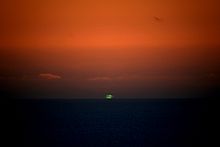Green flash
The green flash , sometimes also called green glow or green ray , is a rare atmospheric-optical natural phenomenon that today, due to the limited visibility due to air pollution, mostly only on the open sea, in high mountains, in the desert or in other places with clearer View is observed. It arises at sunrise or sunset and can be seen as a “green glow” at the top of the sun. Sometimes a "green flash" appears after the sun has set.
Physical explanation
The white light of the sun is refracted in the earth's atmosphere depending on the wavelength and thus broken down into the spectral colors ( dispersion ). Blue light is refracted more strongly than green, and this in turn more strongly than yellow and red. Since the refraction of light is strongest near the horizon, the last flat arc segment of the setting sun is split into its spectral colors here. The solar segment therefore has a red, green and blue sun rim. The differences, however, are very small and are only about one sixtieth of the visible sun diameter from the red to the blue edge of the sun. When the red and yellow inner circle goes down first, only the green and blue borders remain above the horizon. However, blue light is subject to strong scattering in the earth's atmosphere and is therefore hardly visible in the solar disk. Only the color green (in the light spectrum between yellow and blue) is mostly left over and can still be seen for a few seconds.
Sometimes a green glow can also be seen above the last yellow-red sun disk that is in the process of setting. This phenomenon can be explained by the interplay of light refraction and reflection. The sun's disk already appears strangely frayed and deformed when it hits the horizon, as warmer lower layers of air form an interface with denser, colder layers of air. Since light is reflected at the interface from the denser to the thinner medium below a very shallow critical angle , the solar disk appears to bulge upwards at the upper end. These light rays cover the longest path to the observer in the atmosphere and are therefore subject to the strongest wavelength-dependent refraction of light. Similar to the explanation for the green flash after the sun has completely set, the green-wave portion of the light is most likely to reach the observer's eye (see picture on the right).
However, under extremely favorable conditions, it is possible to also observe a blue flash and even a purple flash . (see picture below right)
gallery
La Silla Observatory , January 15, 2006
San Francisco , September 18, 2006
Trivia
- The author Jules Verne uses this phenomenon in his novel Der Grüne Strahl , franz. The title is Le Rayon Vert , which is sometimes translated as The Green Lights .
- The feature film The Green Shine ( Le Rayon vert ) by the French director Éric Rohmer takes up motifs from this novel. The phenomenon can also be seen in the final scene of the film, but it is a trick shot.
- The authors Arkadi and Boris Strugazki mention the phenomenon in their novel Interns .
- In the movie Pirates of the Caribbean: At World's End , a green glow of the horizon after sunset is used as a sign that a dead soul is returning from the underworld.
- In the film Midnight Son - A terrifying love story , the protagonist Jacob paints pictures of sunrises and sunsets. When his girlfriend picks him up at home, they talk about the green lightning bolt.
Individual evidence
- ↑ Kristian Schlegel: From the rainbow to the polar light , Heidelberg; Berlin: Spectrum Academic Publishing House, 1999
- ^ Arbeitskreis Meteore eV - Archive September 2007: Picture of the month September, picture d: Blue and purple flash on La Palma
Web links
- Fred Schaaf: The Green Lightning. In: Astronomy Today. December 2006 (PDF)
- Explanations and photos. In: meteoros.de
- Detailed presentation. In: mintaka.sdsu.edu (engl.)







